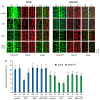ATANN3 Is Involved in Extracellular ATP-Regulated Auxin Distribution in Arabidopsis thaliana Seedlings
- PMID: 36679043
- PMCID: PMC9867528
- DOI: 10.3390/plants12020330
ATANN3 Is Involved in Extracellular ATP-Regulated Auxin Distribution in Arabidopsis thaliana Seedlings
Abstract
Extracellular ATP (eATP) plays multiple roles in plant growth and development, and stress responses. It has been revealed that eATP suppresses growth and alters the growth orientation of the root and hypocotyl of Arabidopsis thaliana by affecting auxin transport and localization in these organs. However, the mechanism of the eATP-stimulated auxin distribution remains elusive. Annexins are involved in multiple aspects of plant cellular metabolism, while their role in response to apoplastic signals remains unclear. Here, by using the loss-of-function mutations, we investigated the role of AtANN3 in the eATP-regulated root and hypocotyl growth. Firstly, the inhibitory effects of eATP on root and hypocotyl elongation were weakened or impaired in the AtANN3 null mutants (atann3-1 and atann3-2). Meanwhile, the distribution of DR5-GUS and DR5-GFP indicated that the eATP-induced asymmetric distribution of auxin in the root tips or hypocotyl cells occurred in wild-type control plants, while in atann3-1 mutant seedlings, it was not observed. Further, the eATP-induced asymmetric distribution of PIN2-GFP in root-tip cells or that of PIN3-GFP in hypocotyl cells was reduced in atann3-1 seedlings. Finally, the eATP-induced asymmetric distribution of cytoplasmic vesicles in root-tip cells was impaired in atann3-1 seedlings. Based on these results, we suggest that AtANN3 may be involved in eATP-regulated seedling growth by regulating the distribution of auxin and auxin transporters in vegetative organs.
Keywords: Arabidopsis thaliana; AtANN3; auxin; extracellular ATP (eATP); seedling growth.
Conflict of interest statement
The authors declare no conflict of interest.
Figures






Similar articles
-
Redox-Responsive Transcription Factor 1 (RRFT1) Is Involved in Extracellular ATP-Regulated Arabidopsis thaliana Seedling Growth.Plant Cell Physiol. 2020 Apr 1;61(4):685-698. doi: 10.1093/pcp/pcaa014. Plant Cell Physiol. 2020. PMID: 32049334
-
Heterotrimeric G Protein-Regulated Ca2+ Influx and PIN2 Asymmetric Distribution Are Involved in Arabidopsis thaliana Roots' Avoidance Response to Extracellular ATP.Front Plant Sci. 2017 Sep 1;8:1522. doi: 10.3389/fpls.2017.01522. eCollection 2017. Front Plant Sci. 2017. PMID: 28919907 Free PMC article.
-
LRK10L3 and BAK1 are collaboratively involved in extracellular ATP-regulated seedling growth of Arabidopsis thaliana.New Phytol. 2025 Sep;247(6):2709-2725. doi: 10.1111/nph.70352. Epub 2025 Jun 29. New Phytol. 2025. PMID: 40583302
-
Regulation of seedling growth by ethylene and the ethylene-auxin crosstalk.Planta. 2017 Mar;245(3):467-489. doi: 10.1007/s00425-017-2651-6. Epub 2017 Feb 10. Planta. 2017. PMID: 28188422 Review.
-
Extracellular ATP: an emerging multifaceted regulator of plant fitness.Plant Biotechnol J. 2025 May;23(5):1771-1782. doi: 10.1111/pbi.70006. Epub 2025 Feb 12. Plant Biotechnol J. 2025. PMID: 39937654 Free PMC article. Review.
Cited by
-
The intrinsically disordered C-terminus of purinoceptor P2K1 fine-tunes plant responses to extracellular ATP.FEBS Lett. 2023 Aug;597(16):2059-2071. doi: 10.1002/1873-3468.14703. Epub 2023 Jul 27. FEBS Lett. 2023. PMID: 37465901 Free PMC article.
-
Rice OsANN9 Enhances Drought Tolerance through Modulating ROS Scavenging Systems.Int J Mol Sci. 2023 Dec 15;24(24):17495. doi: 10.3390/ijms242417495. Int J Mol Sci. 2023. PMID: 38139326 Free PMC article.
-
Radiation-Tolerant Fibrivirga spp. from Rhizosphere Soil: Genome Insights and Potential in Agriculture.Genes (Basel). 2024 Aug 9;15(8):1048. doi: 10.3390/genes15081048. Genes (Basel). 2024. PMID: 39202408 Free PMC article.
-
CPK28 is a modulator of purinergic signaling in plant growth and defense.Plant J. 2024 May;118(4):1086-1101. doi: 10.1111/tpj.16656. Epub 2024 Feb 3. Plant J. 2024. PMID: 38308597 Free PMC article.
-
Growth regulation by apyrases: Insights from altering their expression level in different organisms.Plant Physiol. 2024 Feb 29;194(3):1323-1335. doi: 10.1093/plphys/kiad590. Plant Physiol. 2024. PMID: 37947023 Free PMC article. Review.
References
LinkOut - more resources
Full Text Sources
Molecular Biology Databases

